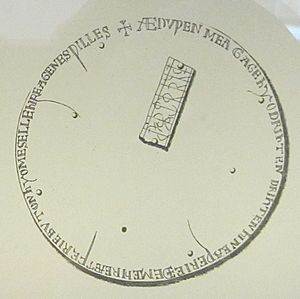Ædwen's brooch facts for kids
The Ædwen's brooch is a special silver brooch from the early 1000s. It is also known as the Sutton brooch. This ancient piece of jewelry has a secret message carved on its back. Today, you can find it at the British Museum in London.
Contents
Discovery and History
This amazing brooch was found by accident in 1694. A farmer was ploughing a field in a place called Sutton, in England. Along with the brooch, he found a hidden collection of valuable items. This collection, called a "hoard," included old coins and gold rings.
For many years, the brooch was kept in private collections. Then, in 1951, it was found again! The British Museum quickly bought it so everyone could see and study this important piece of history.
What Does it Look Like?
The Ædwen's brooch is a round, flat piece of silver. It has nine small, cone-shaped silver bumps on it, though one is now missing. The brooch is also decorated with beautiful carvings. These carvings show four circles that overlap, creating patterns that look like flowers.
Inside these circles, you can see pictures of different animals and plants. The style of these decorations is similar to a type of Viking art called the Ringerike style. This shows how different cultures influenced art back then.
The Mysterious Inscription
One of the most interesting things about the brooch is the message carved on its back. This message is a type of curse. It warns anyone who might try to take the brooch from its rightful owner, a person named Ædwen (or Æduwen).
The message is written in Old English, which is a very old form of the English language. It says:
- + ÆDVǷEN ME AG AGE HYO DRIHTEN / DRIHTEN HINE AǷERIE ÐE ME HIRE ÆTFERIE / BVTON HYO ME SELLE HIRE AGENES ǷILLES
In modern English, this means:
- "Ædwen owns me, may the Lord own her. May the Lord curse him who takes me from her, unless she gives me of her own free will."
This inscription tells us that Ædwen really wanted to keep her brooch safe! There's even a short film that shows the curse being spoken in both Old English and modern English.
Secret Symbols
There's another small inscription on the part of the brooch that once held the pin. This inscription has seven symbols that look like runes. Runes were an old alphabet used by some Germanic people. However, these symbols are "pseudo-runic," meaning they look like runes but don't form real words or a known runic message. They add another layer of mystery to this ancient treasure.
See Also
- Anglo-Saxon art
- Disc brooch
- Viking art



